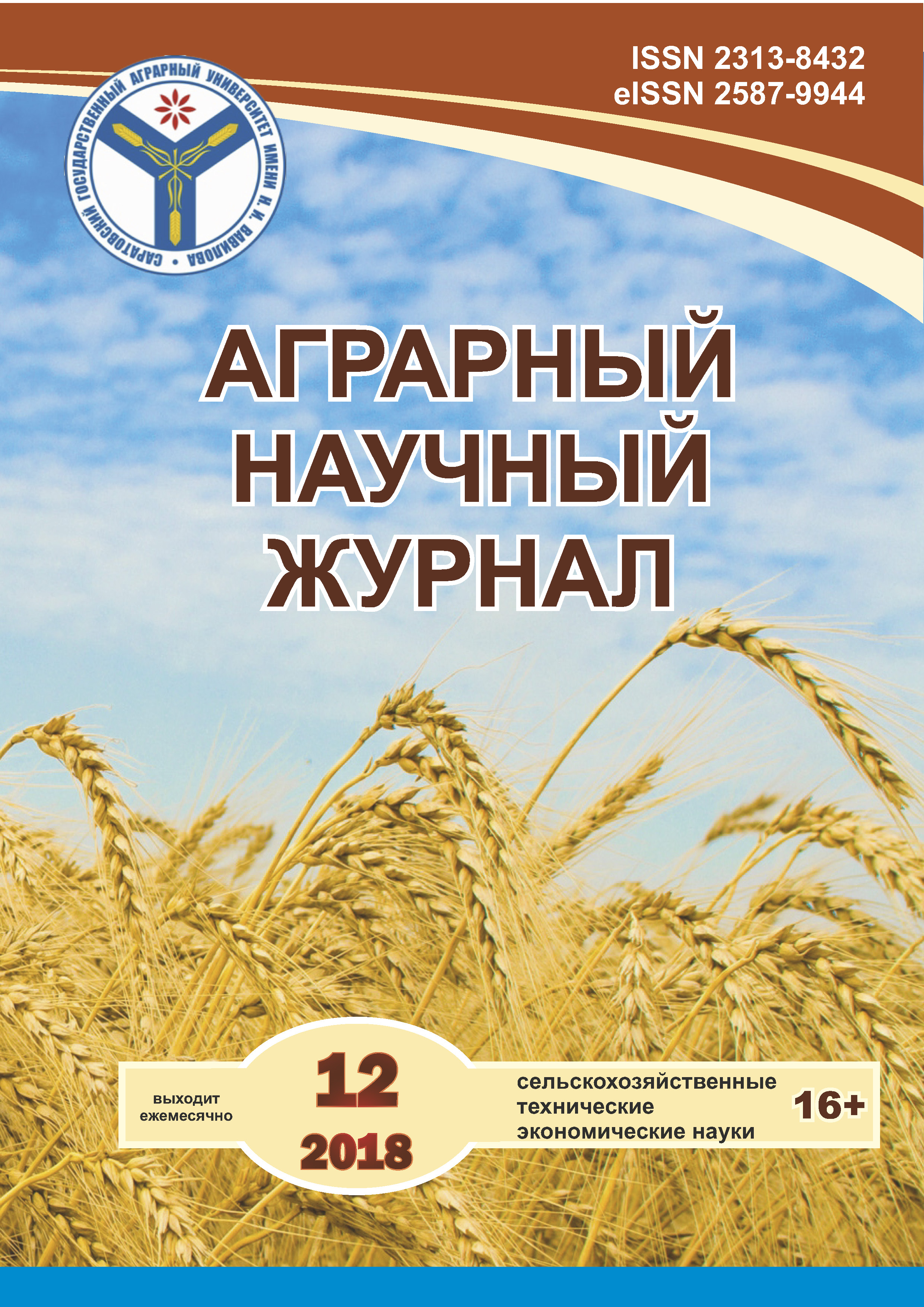Quality of spring wheat grain at cultivating with modern technologies
DOI:
https://doi.org/10.28983/asj.v0i12.655Keywords:
direct sowing, spring durum wheat, grain qualityAbstract
The results of studies in the grain-crop rotation (2011-2017 years) to study the impact of direct seeding technologies on the quality of grain and the efficiency of spring durum wheat cultivation on the chernozems of the middle Volga region are presented. Grain of spring durum wheat is impractical to use for feed purposes, while in the Volga region has not been studied the effect of direct sowing with different levels of intensity on the quality of grain. Favorable weather conditions for the growth and development of culture established in 2017 (SCC for may-August= 0.94). In other years, the SCC was at and below the average annual values (0.45-0.74). Complex application of fertilizers and plant protection products providing the same productivity and quality of grain, in comparison with the intensive background of traditional technology, contributed to an increase in conditional net income and profitability by 1534.3-1902.7 rubles/ha and 34.3-34.4%, respectively. Compared with traditional technology without the use of fertilizers and insecticides, the advantage of the best options increased to 3826.4-4184.3 rubles/ha and 47.0-47.1 %. The indicators of grain quality significantly influenced the SCC vegetation period of culture. Improved water availability of crops contributed to the increase in weight of 1000 seeds from 36.3-36.9 g to 42.8-44.9 g and reduce the nature of grain from 782.0-791.8 g/l to 750.9-767.9 g/l (1.8-5.4 %). The highest protein content was found in dry years – 15.4-16.3 %, which is 1.1-3.5 % more than in wet years. On the basis of the conducted research to improve the efficiency and quality of grain at the level of the required indicators, the technology of direct sowing with complex application of plant protection against pests and weeds, pre-sowing application of nitrogen fertilizers N30 is proposed.
Downloads
References
2. Горянин О.И., Горянина Т.А. Перспективы возделывания полевых культур в Среднем Заволжье // Успехи современного естествознания. – 2018. – № 4. – С. 49–53.
3. Данилов А.Н., Летучий А.В. Сравнительная оценка удобрений и способов основной обработки почвы в полевом севообороте // Аграрный научный журнал. – 2016. – № 6. – С. 3–7.
4. Ерофеев С.Е. Технология возделывания яровой пшеницы на чернозёме выщелоченном, адаптированная к условиям Ульяновской области // Пути решения проблем повышения адаптивности, продуктивности и качества зерновых и кормовых культур: материалы Междунар. науч.-практ. конф., посвящ. 100-летию Самарского НИИСХ и 70-летию Поволжского НИИСС. – Самара, 2003. – С.123–124.
5. Жученко А.А. Проблемы ресурсосбережения в процессах интенсификации сельскохозяйственного производства // Пробле¬мы адаптивной интенсификации земледелия в Среднем Поволжье: сб. науч. тр., посвящ. 135-летию со дня рождения Н.М. Тулайкова / ГНУ Самарский НИИСХ. – Самара, 2012. – С. 8–33.
6. Казаков Г.И., Милюткин В.А. Экологизация и энергосбережение в земледелие Среднего Поволжья. – Самара: РИЦ СГСХА, 2010. – 245 с.
7. Концепция формирования современных ресурсосберегающих комплексов возделывания зерновых культур в Среднем Поволжье / сост. В.А. Корчагин. – 2-е изд., перераб. и доп. – Самара, 2008. – 88 с.
8. Кузина Е.В., Якунин А.И. Изменение урожайности озимой пшеницы и качества зерна в зависимости от способов основной обработки почвы и уровня удобрений //Аграрный научный журнал. – 2016. – № 11. – С. 24–29.
9. Нарушев В.Б., Косолапов Д.С., Одиноков Е.В. Влияние прямого посева на плодородие почвы и продуктивность полевых культур в степном Поволжье // Плодородие. – 2013. – № 5 (74). – С. 6–8.
10. Огарёв В.Ф. Поле и урожай. – Саратов: Приволж. кн. изд-во, 1990. – 256 с.
11. Прямой посев полевых культур и его эффективность / Г.Р. Дорожко, О.Г. Шабалдас, В.К. Зайцев, Д.Ю. Бородин // Земледелие. – 2013. – № 8. – С. 20-23.
12. Способ основной обработки, урожай и качество зерна / Г.Н. Черкасов [и др.] // Земледелие. – 2011. – № 5. – С. 18–19.
13. Чекаев Н.П., Вдасова Т.А., Кочмина Е.О. Изменение агрофизических показателей чернозёма выщелоченного и урожайности яровой пшеницы в условиях внедрения технологий No-till // Нива Поволжья. – 2015. – № 2 (35). – С. 74–79.








